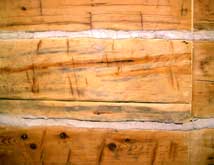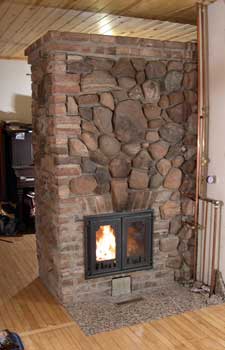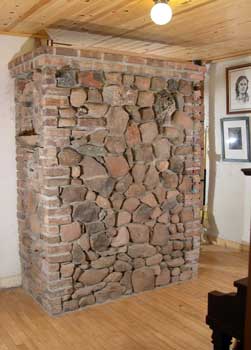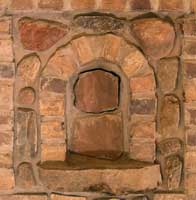Grace Heitsch's Heater
 Grace Heitsch approached me about building a heater in her existing house. The original house was made of 16-inch logs hewn flat with an axe and stacked on edge to form the walls. We had to create a heater that could heat through the original log walls to heat the rooms that had been added. We knew that this would be a challenge, so we planned to add two stainless heat exchangers inside the throat of the heater in case we needed to circulate hot water to the radiators in the extremities of the house. Currently, the hot water is being used to heat water for bathing and cleaning, but with some reconfiguration, the heat could be used to ensure comfort in the less-centralized rooms.
Grace Heitsch approached me about building a heater in her existing house. The original house was made of 16-inch logs hewn flat with an axe and stacked on edge to form the walls. We had to create a heater that could heat through the original log walls to heat the rooms that had been added. We knew that this would be a challenge, so we planned to add two stainless heat exchangers inside the throat of the heater in case we needed to circulate hot water to the radiators in the extremities of the house. Currently, the hot water is being used to heat water for bathing and cleaning, but with some reconfiguration, the heat could be used to ensure comfort in the less-centralized rooms.

There was little room in the center of the old house, so it was vital that I design a heater from scratch and configure it for the needs and wants of the house and inhabitants respectively.

I created a nice Russian core with five horizontal flues that connected to the existing chimney, which had been well-built.
We had to cut through the floor and run the foundation up from the basement to hold the heater on the first floor, but this created a nice alcove for the antique stove that Grace uses to curb the chill and humidity in her old basement. The block work stores heat from the stove nicely while holding the masonry heater above.
 To coordinate with the sturdiness of the old log structure (and to use local resources) we decided to use fieldstone once piled in the fields by those who cleared the land to plow it. As the log home had slowly been reconfigured and added on to, we thought we could spice up the stonework with some old bricks that Grace had reclaimed in the city of Ashland. The rounded, weathered stones complement the sturdy, rectangular bricks. The locally gathered materials for the outside veneer of the heater made for a heater that belongs in the house, and saved a lot of money and resources.
To coordinate with the sturdiness of the old log structure (and to use local resources) we decided to use fieldstone once piled in the fields by those who cleared the land to plow it. As the log home had slowly been reconfigured and added on to, we thought we could spice up the stonework with some old bricks that Grace had reclaimed in the city of Ashland. The rounded, weathered stones complement the sturdy, rectangular bricks. The locally gathered materials for the outside veneer of the heater made for a heater that belongs in the house, and saved a lot of money and resources.
 Grace proved to be a very flexible and creative person who was great to work with, so she was pleased when we surprised her with a little niche on the end of her heater.
Grace proved to be a very flexible and creative person who was great to work with, so she was pleased when we surprised her with a little niche on the end of her heater.
We put a slide damper near the ceiling of the upstairs landing so that the original chimney could store and radiate heat to the second floor, just as the heater does for the first floor.